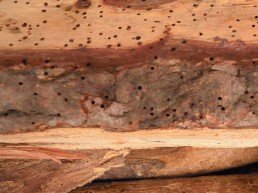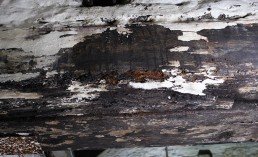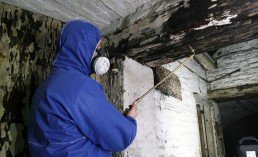What is Woodworm Treatment?
What is woodworm treatment?
The term woodworm might conjure up cartoon-type images, but it is, in fact, something of a misnomer since it tends to be a different type of creepy crawly - beetles - that inflict the damage.
And there is one main offender: Anobium punctatum aka the Common Furniture Beetle. Although it mainly thrives outdoors, infesting the likes of tree trunks, branches and the like, the Common Furniture Beetle can cause serious damage if ever it creeps and crawls its way to indoor timber.
So how might that happen? Spring and summer is the time of year when the reproductive process starts – the beetles emerging from the wood crevices that are normally their habitat before the females return to lay eggs, which usually number around 30.
The eggs will hatch about a month later and the grubs will then bury themselves even further into the timber. They will spend about two to four years there, eating the wood and slowly maturing into lavae.
The lava will then dig a chamber just beneath the surface of the wood and the pupation process will begin – culminating when the adult beetle cuts a hole in the surface of the wood. Thus the process repeats itself.
It’s the by-product of the reproductive cycle – the beetle’s emergence holes and the dust (known as frass) they create – that are the tell-tale signs of woodworm infestation.
What is woodworm infestation?
The woodworm infestation can be highly significant because, depending upon the conditions, it can occur in a number of different timber types and products: from wooden ornaments, through furniture and building timbers.
It goes without saying that the latter can prove a particular problem: if left unchecked, an infestation of building timbers can compromise your building’s structural integrity, leading, in the most extreme cases, to total collapse.
In highlighting such an eventuality, it must be pointed out that there are other offenders besides the Common Furniture Beetle. There is, for example, the Death Watch Beetle, or Xestobium rufovillosum, which tends to be found in older buildings, particularly those with hardwoods that are either damp or have been affected by fungal decay.
And there is also the House Longhorn Beetle aka Hylotrupes bajulus. Larger than the other species, it can infest sapwood (the soft outer layers of recently formed wood between the heartwood and the bark) and is mainly associated with roofing timbers.
The good news, demographically-speaking for a North Yorkshire-based company like Danford, Brewer & Ives, however, is that the House Longhorn Beetle limits its habitat to just a small part of South East England. Even so, spare a thought for the owners of properties that suffer infestations: if left unchecked, they can lead to severe structural weakening in just a short period of time.
How to treat woodworm infestation?
So how to go about treating a woodworm infestation? When one is discovered, a particular course of action should always be recommended by a team of experts, who will assess the conditions and circumstances surrounding the case.
First of all, a surveyor will make a thorough inspection of the infested timber, noting the type of wood, its accessibility and assessing the various risks.
Then, the timbers will need to be cleaned thoroughly to remove excess debris, before preservatives are applied.
A common and cost-effective form of treatment involves either spraying or using a brush to apply water-based insecticides.
Treatment of smaller items such as furniture or even ornaments can, meanwhile, be undertaken using either heat or freezing treatment, as well as gas fumigation.
All such methods require both training and a high measure of competency and it goes without saying that DB&I’s team are more than capable of undertaking such specialist work. Moreover, we’re always keeping our eyes peeled for any new innovations and methodologies.
If you would like more information on woodworm - or any of the other building services Danford Brewer & Ives offer, such as timber treatment, basement conversions, extensions or building maintenance – then please contact us. As always, we’re more than happy to help
What Is Dry Rot?
If you ask most people what rot is, chances are they’ll conjure up a vision of wood left exposed to damp. So if it’s not old window frames trying, and increasingly failing, to fend off the elements, then it’s beams exposed to a leaky roof, or flooring and plasterwork lying prone near dodgy pipework.
Rot is caused by damp, so it follows that rot is wet – ergo there’s a thing called wet rot. But there’s also dry rot as well.
What’s the difference? Both have the same root cause: fungi, which breed and attack wood that’s exposed to damp. Timber with 20 percent moisture content or higher is most prone.
Wet rot is the more common type but is less serious and usually confined to timber that stays…wet. Door and window frames commonly fall prey. Both wet and dry rot starts in the same way: when fungi produce millions of microscopic spores into the air. If they fall on untreated damp wood they will germinate, via tubes known as hypha. These then spread to form a mass of threads called mycelium. The mycelium eats into the wood, spreading through it using the hyphal threads which supply water and nutrients.
The difference between wet and dry rot centres on the type of fungi that infects the wood. There are several common types, but the one that causes dry rot is known as Serpula lacrymans.
And make no mistake: this is, as far as a property’s structural integrity is concerned, the enemy. It can destroy wood and, if left unchecked, can wreak havoc. Moreover, unlike other fungi, it can spread from infected timber onto the surface of nearby stone or brick walls. The hyphal threads penetrate mortar and plaster, meaning that large areas of the wall can become infected. The problem is compounded, well and truly.
How to spot dry rot? Its appearance might be given away by the affected timber appearing darker and also cracking. Wet rots, by contrast, tend to produce a bleaching effect.
Knowing how to tell dry and wet rot apart is hugely important, because each requires a different form of treatment. This is precisely where you need an experienced, professional service, such as that offered by Danford Brewer & Ives.
A detailed inspection should be carried out by a specialist, who will then submit a report detailing both the cause of the rot and the proposed action.
As a rule of thumb, the following areas will be investigated:
• The roof: are there blocked gutters, for example, or missing/broken/displaced tiles/slates?
• The walls: has the mortar/plaster deteriorated; is there faulty/missing damp proof course, blocked air bricks, cracked or broken pipes, or perhaps an overflow from the cistern/water tank?
• Internally: is there excessive condensation in, say, the bathroom and kitchen; moisture close to external faults, solid floors, trapped flood water, or defective plumbing?
Keeping on top of rot can prove difficult; even being aware of it is not easy. That said, a little time and effort in this regard can go an awfully long way.
Fortunately, though, strides are always being made in terms of greater understanding, improved solutions and best practice, meaning that not only is help readily at hand, but that it draws from a greater depth of knowledge. The upshot, therefore, is a better chance to combat and resolve the problem.
Danford Brewer & Ives have a team of experts who can produce reports and quotations for any necessary specialist dry rot work. Moreover, we keep abreast of all the latest innovations, methods and technologies.
If you would like more information on and detail about dry rot - or any of the other building services we offer, such as timber treatment, basement conversions, extensions or building maintenance – then please contact us. As always, we’re more than happy to help.
What Causes Condensation?
What Causes Condensation?
“In this world, nothing can be said to be certain, except death and taxes,” wrote Benjamin Franklin in 1789. For the purposes of this blog, it’s (very briefly) worth considering whether he dreamt up this line while gazing out of his study window on a warm summer’s morning. Because if he did so in the depths of winter, after noticing patches of moisture on the window’s sill, then he might have added another certainty to the list.
Is there a homeowner out there who hasn’t sighed when he or she opens the curtains and sees such a thing? Or perhaps spotted that wallpaper near a radiator – over which he or she casually drapes clothes to dry during the winter months – has started to bubble and peel.
Add plaster deterioration to the list and it’s clear that the consequences of condensation can be a pain. But when one adds the potential for the growth of bacteria and mould (which may cause respiratory problems) and even rot (which may, if left untreated, cause structural problems) it’s clear that consequences of condensation can – if left unchecked – be significant.
‘But what can I do?’ asks the owner. Well…exactly. Simply living within walls and under a roof creates condensation; the very act of breathing is a contributory factor, as are cooking, bathing, washing and drying clothes. Don’t worry, though: we’re not going to recommend that you always eat out, never bathe or do laundry – all the while holding your breath for as long as you possibly can.
Condensation is basically a dampening of the air until water gathers on cold surfaces such as windows, tiles and walls. And the colder the room, the worse it can be. Yet simple steps can help fight it. For starters, get hold of a dehumidifier and see for yourself how much water it can collect in a day.
Here are a few other ideas:
- Temperatures might be on the low side, but that shouldn’t stop you from opening a window – if just a little – to reduce moisture
- Wipe down surfaces, such as window sills, where moisture tends to collect
- When cooking always use pan lids and open a window to ventilate the kitchen
- When drying clothes, try and do it outside. But if that’s not viable (and, let’s face it, it isn’t quite a lot of the time) use a clothes horse rather than place clothes on a radiator. Better still, set up a dehumidifier nearby
- If you use a tumble dryer that isn’t self-condensing, make sure it’s vented properly
- When running a bath, turn the cold tap on before the hot; it’ll reduce the amount of steam
- After bathing or showering, wipe down the tiles to remove the surface water. Then open the window and shut the door
- When using extractor fans fitted in either the kitchen or bathroom, remember to close all windows and doors so they work more effectively
- A temptation might be to switch the heating off to save money. However, heating set at a moderate temperature tends to be more cost-effective in the long run – while helping prevent condensation, of course
- Always keep your house ventilated (even during the winter) and prevent the blocking of airbricks e.g. by leaves
- Try not to place furniture against walls - particularly outside walls - as this prevents air from circulating freely and traps moisture
The war can never be won; it’s more a case of holding the enemy in check. But what if you’re losing the fight? Say you’ve bought a new property that does have damp and needs treatment?
Danford Brewer & Ives can help you. Damp is a tricky phenomenon to treat effectively – there are different types, misdiagnoses can happen and the wrong form of treatment can lead down a (potentially expensive) blind alley. However, we have the experience and nous to assess each and every situation and suggest an appropriate course of action.
Please contact us if you have any queries – whether it’s about condensation, damp, or any of the other building services we offer, such as timber treatment, basement conversions, extensions or building maintenance. As always, we’re more than happy to help.
Wet rot treatment & why a timber survey is needed
If there’s ever a time to treat damp and wood rot, it’s springtime. But, then, if there’s ever a time for rot to sink its clutches into your property, it’s during winter.
After all, your property has born the brunt of the elements. But at what cost? The snow, wind, and rain might have gone but all can leave behind moisture, which finds its way in through various nooks and crannies.
Timber is where damp takes hold, and if it’s left untreated then rot can develop.
There are two types - dry and wet rot – and it’s the latter we shall focus on here…
…which is good news, in a sense. Why? Because wet rot is not as pervasive as dry rot. It tends not to spread as far, and its consequences tend to be less damaging. The latter can eat its way through a property, affecting wood as well as plaster and brickwork. In terms of structural integrity, it has the potential to be catastrophic.
Wet rot tends only to cause damage in areas that are – and remain – wet.
Poor Ventilation
Poor ventilation below floors may be a cause of wet rot, as might rising or penetrating damp, water leaks and the like.
It’s caused by fungi which multiply in the right conditions and attack wood. Roughly speaking, timber with 20 per cent moisture content or higher is susceptible.
The process starts when the fungi breed by showering millions of microscopic spores into the air.
If they fall on untreated wood they will germinate – via tubes called hypha which spread to form threads called mycelium.
The mycelium eats at the wood and uses the threads (which supply water and nutrients) to propagate.
Again, however, when comparing how dry rot and wet rot can take hold, the latter is not quite so malignant. It will not, for example, spread onto the surface of adjacent stone or brick walls.
That’s because there is fewer mycelium – meaning that wet rot is typically confined to the area of dampness.
Even so, timber exposed to the damp will still lose its structural integrity if left untreated.
Signs of Wet Rot
Tell-tale signs of wet rot might include a whitening, or bleaching, effect - which does not refer to the colour of the mould, but the shade that the timber turns when affected.
By contrast, brown rot will darken the wood, which will disintegrate in small cracks.
While different strains of fungi have different features, broadly speaking they are all similar in appearance and the treatments are also similar.
Regarding identification and treatment, it’s crucial that the type of wood rot – whether it’s dry or wet, in other words - is identified before any course of action is considered. Each requires a different form of treatment.
A detailed inspection should be carried out by a specialist, who will then submit a report detailing both the cause of the decay and the proposed action.
As a rule of thumb, the following (and most likely more besides) will be investigated:
- The Roof. Are the gutters blocked? Perhaps tiles are missing, broken or displaced?
- The Walls. Has the mortar deteriorated? Is the damp-proof course either faulty or missing? Are the air bricks blocked? Maybe pipes are cracked or broken, or a water tank is overflowing?
- Perhaps there is condensation in, say, the bathroom and kitchen? Or maybe there’s moisture close to external gaps or cracks, floors, trapped floodwater, or defective plumbing?
Keeping on top of – or even being aware of – rot can be difficult, but innovations are constantly being made so better help and advice are readily at hand.
If there is doubt, a timber survey is probably your best bet to identify both the cause and remedy, which may include specialist treatment.
Danford Brewer & Ives have a team of expert surveyors who can produce reports and quotations for any necessary specialist works. Moreover, we keep abreast of all the latest innovations, methods and technologies.
If you would like more information on and detail about wet rot - or any of the other building services we offer, such as timber treatment, basement conversions, extensions or building maintenance – then please contact us. As always, we’re more than happy to help.
Damp Proofing Specialists Invest In New Technology
Damp Proofing Specialists DBI Invest in New Technology
At Danford Brewer & Ives we are striving to stay up-to-date with technology in the workplace. As within any business, we rely more and more on technology for daily tasks. The damp proofing industry needs to bring itself up-to-speed with technology not only to keep up-to-date but also to attract younger people into the sector. Younger people, whether they are in primary school or high school leavers, are becoming more and more technology-dependent, with most aspects of their lives involving technology at some point. Going into schools, speaking to younger people, informing them of the different roles that are involved in the construction industry, and showing them what technology is involved, will all help to inspire the next generation to join this industry.
So, what ways are we at Danford Brewer & Ives introducing new technology?
Our App
We have introduced a new app into our business which has been researched, developed and written uniquely for us. Working alongside development company Genesis Business Systems, and after 2 years of hard work and investment with the help of CITB, we now have an app which has updated all our systems and is a step towards updating the construction industry. It is also helping us to help the environment, hugely reducing the amount of paper used throughout the company!
Instead of using paper forms for surveys or job details, all our surveyors and site operatives now have tablets with digital forms and the ability to draw and take photos.
The app has allowed us to take enquiries in a more detailed form, ensuring the damp surveyor is provided with more information prior to the survey being carried out. We can record findings more clearly and pass it to the office quicker, allowing customers to receive reports usually within 24-48 hours of the damp survey been carried out. Information passed onto our onsite operatives is also clearer and allows them to complete forms quicker and easier.
Although this app has been designed for us, it can be adapted and rolled out to other businesses in the construction industry.
New website
At the beginning of 2018, our website had a complete make-over! Re-designed to make it easier for customers to view, faster loading speeds, and a live chat section, we hope that our new website provides the information our customers require clearly.
Phone system
Last year we had a new telephone system installed, which has increased the number of our lines, allowed clearer calls and smoother call transfers, with all our regional phone numbers now come in through the new system. We have also updated our on-hold music, which has been composed especially for us by Ryan Blockley!
As well as helping us update our systems, the main aim of using this new technology is to provide a better service for our customers! Happy customers and referrals are what every business desires. We at Danford Brewer & Ives strive to provide the best possible service we can to ensure customers are satisfied and happy.
With the help of new technology, training our staff and updating our methods and systems, we continue to improve. We want more comments like these -
‘I have always found the staff at Danford Brewer & Ives to be polite, professional, friendly and extremely helpful. The surveys are carried out promptly and professionally followed by excellent written reports and I would have no hesitation in recommending their services to others.’
Estate Agents - Richmond
‘Thanks, can I say that your guy was first class and made every effort to keep the dust down to a minimum.’
I.G – Harrogate
‘very pleased with the efficiency with which the two chaps worked yesterday. Thank you to them as well!’
P.A – Keighley
If you are
How much does damp proofing cost?
Cost of damp proofing
It’s easy to jump to the worst possible conclusion when spotting, say, tell-tale bubbles and/or peeling wallpaper, or perhaps a dank and ugly patch of mould: that your property is as damp as a ducks’ nest, that the situation is catastrophic and that remedying the problem will come at the expense of that trip of a lifetime you’ve been hankering after.
The good news, though, is that it’s rare indeed that damp is as bad as it initially seems. Of course, the wallpaper will have to be stripped and the wall most likely re-plastered. But in most cases, the masonry itself will be retrievable. It simply needs to dry out.
Three main factors are responsible for damp: condensation, rainwater and rising damp, and it’s the latter phenomenon that we’re concerned with here.
So what is it? Rising damp is the common term used for the upward movement of groundwater in the lower sections of walls by a process called capillary action. It’s characterised by a "tide mark" on affected walls, caused by salts contained in the groundwater.
When the water evaporates, the salts crystallise and can cause plaster to deteriorate. And with water continually wending its way up, the situation will perpetuate. (A side-effect of rising damp, incidentally, is that a damp wall will lose more heat.)
So how to tackle the problem? It’s most likely the case that the property already has damp proofing older houses use, for example, a layer of slate between the brickwork, while well-built modern houses include damp proofing in the form of a synthetic damp-proof course (DPC), about 15 cm above ground level, to act as a barrier through which water – in theory - cannot pass.
However, the damp-proof course can be broken or incomplete, allowing moisture to find a way in – or rather up: ‘bridging’ as it is known.
Poor drainage can also be a factor, so it’s certainly worth checking for standing water in crawlspaces and/or the basement. Another factor, meanwhile, might be any raising of the ground level next to an external wall. If air bricks are now blocked, or ground-level stands above the original damp-proof course, then moisture can find a way up.
It stands to reason that the more damp-proof course there is, the less chance there is of rising damp developing. But just a few millimetres of ‘bridging’ is sufficient to cause it.
And how is rising damp treated? That depends on its severity and each case is unique. Examples of the treatments Danford Brewer & Ives offer are:
- Removing the surrounding soil or bridging material to be a minimum of 150mm below the existing damp-proof course
- Injecting a chemical damp-proof course
- Replacing any damp or rotten flooring
- Removing and replacing any plasterwork, skirting boards, radiators etc. if necessary
One important thing to stress, though, is the competence and experience of the person(s) investigating the problem: misdiagnosis can happen – and since the wrong form of treatment could then be prescribed, the overall cost will eventually be higher.
An example: we mentioned earlier how salts form causing plaster and wallpaper to peel. This might be a feature of rising damp but other phenomena (such as heat from a fire) can also cause salts in masonry to crystallise – resulting, perhaps, in damp-proof course work that is completely unnecessary.
And the cost? A good rough guide is £60 per linear metre +vat. Therefore, an average-sized living room of 4 metres by 4 metres would cost around £270 + vat per wall. But, as mentioned, each case is unique. What we can say with a measure of confidence, though, is that most jobs will take us a couple of days.
If you have any queries – whether it’s about damp proofing or any of the other building services Danford Brewer & Ives offers, such as timber treatment, basement conversions, extensions or building maintenance – then please contact us. As ever, we’d be delighted to hear from you.
The Causes And How To Treat Condensation
Causes of Condensation and How to Treat It
Winter is here, well and truly. The Most Wonderful Time of the Year is sadly no longer, everyone seems to have a cold and those that don’t are either dieting or down the gym. It’s purgatory for all the good times we’ve been having and it’s precisely at this juncture that, if you hadn’t buried the thought beforehand, one tends to notice those little imperfections around and about the place.
I mean, look at the state of that patio for one thing. Green and yellow? Is that rust on the wheel arch of the car? And what’s that…fur, it looks like…that’s suddenly sprouted on the kitchen window? Eeeeesssh.
Well, no prizes for guessing what the cause is each and every time: water, moisture, damp, condensation. It feels like it’s here, there and everywhere right now. Best draw the curtains and light a fire, right? Right, except that even this comforting act of blocking out the cold, wet, darkness propagates what it seeks to avoid. Oh no? Well, look behind your living room curtains at the window sill the following morning. Fighting it is a pain in you know where, but it’s an ongoing battle that we must square up to.
Like most battles, it’s attritional; if we apply ourselves often then it’s possible to fight back. And think of the potential consequences of not being bothered: rot, plaster deterioration, wallpaper that bubbles and peels. Not only that, condensation can also cause bacteria to flourish – leading potentially to respiratory problems – and might even cause structural problems if, say, floor timbers are affected.
Damp is caused by rain, rising damp, and condensation. It’s the latter we’re concerned with here and there is no escaping it. Its presence is a 100 per cent certainty since the very act of breathing creates moisture. If you have a dehumidifier, you’ll see how much water can collect over, say, a 24-hour period.
Everyday actions such as cooking, bathing, washing and drying clothes also cause moisture – dampening the air until water gathers on cold surfaces such as windows, tiles, and walls. And the colder the room, the worse the problem can be. Yet simple steps can help prevent it from taking hold:
- It might be cold outside, but that doesn’t prevent you from opening the window(s) a little to reduce moisture in a room
- Regularly wipe down surfaces (such as window sills for example) where moisture collects
- When cooking always use pan lids and open a window to ventilate the kitchen
- When drying clothes, try and do it outside. But that’s hard at this time of year, so how about using a clothes horse in a room that’s cool (but not cold)? Also, set up a dehumidifier nearby.
- Don’t dry clothes on radiators: this is one of the main causes of condensation and can cause mould growth
- If you use a tumble dryer, and if it isn’t self-condensing, make sure it is properly vented
- When bathing, run the cold tap before the hot; this will reduce the amount of steam produced
- After bathing or showering, wipe down the tiles to remove the surface water. Then open the window (notice the vapour billowing out) and shut the door
- When using extractor fans fitted in either the kitchen or bathroom, remember to close all windows and doors so they work more effectively
- A temptation might be to switch the heating off to save money. However, heating set at a moderate temperature tends to be more cost-effective in the long run – while also helping prevent condensation, of course
- Always keep your house ventilated, even in wintertime, and prevent the blocking of airbricks e.g. by leaves
- Try not to place furniture against walls – particularly outside walls – as this prevents air from circulating freely thus trapping moisture
As mentioned, fighting damp is an ongoing war of attrition. Yet the enemy can be held in check with a little-concerted effort. But what if you appear to be losing the fight? That’s where we at Danford Brewer & Ives come in: if damp is taking hold then you will need a competent, experienced team to investigate; misdiagnosis does happen and the costs can be high if the wrong form of treatment is undertaken.
We have a range of standard and specialist extractors, heat recovery fans and positive pressure, condensation control units, these can be installed in properties to reduce the build-up of internal moisture. We can consider linings and the insulating of colder surfaces and sometimes suggest ways to improve heating, all of these will help stop problems with condensation.
Please contact us if you have any queries – whether it’s about condensation, damp, or any of the other building services we offer, such as timber treatment, basement conversions, extensions or building maintenance. As always, we’re more than happy to help.
Home Building & Renovating Show 2017
Danford, Brewer & Ives are proud to announce that we will once more be exhibiting at the Northern Homebuilding & Renovating Show, which is being held at the Harrogate Convention Centre between November 3rd and the 5th.
The Homebuilding & Renovating Show’s website describes it as ‘the go-to exhibition for self-builders and renovators’, adding that ‘no matter what stage your project is at, there will be sessions, experts and exhibitors at the show to help you bring your project to life’.
What sort of projects? Well, with no fewer than 224 exhibitors on show, it might be easier to ask what sort of projects aren’t catered for. Some of the more obvious ones are as follows: building your own home; renovating your own home; creating extensions and conversions in your home; home eco and heating; plus kitchens, doors and windows.
Moreover, there are seminars galore – from a Beginners Guide To Building Your Own Home, to The Benefits Of Biomass Fuel – while visitors also get the opportunity for some one-on-one advice, with builders, architects, and planning experts on hand to offer a helping hand. And for those visitors whose projects may have left them staring down spreadsheets whilst scratching their heads and questioning the figures, there’s even a cost estimation service.
But what about those visitors who want to hear more about…say…damp proofing, timber treatment, basement conversions, extensions, building maintenance and the like? What can the Northern Homebuilding & Renovating Show offer them??…(cough cough)…we know precisely what. And where: Danford, Brewer & Ives will be located at stand number M220. This is now the third year we have exhibited at the Northern Homebuilding & Renovating Show and, with our biggest stand to date, we’re also very much hoping that it’ll be our biggest success yet.
Certainly, damp-proofing is a big part of what we do and if that poses a problem then we certainly think you’ll be coming to the right place. Maybe it’s the time of year, but when the nights start to draw in and the central heating is turned back on, damp, mould and condensation are all niggles that suddenly seem to niggle just that little bit more. The likes of rot, mildew and even structural problems can result in the long term; yet with the right guidance and necessary remedies put in place, the consequences of damp, mould and condensation can be controlled easily enough.
Under normal circumstances, a surveyor would identify the problem, the cause, and remedy, and specialist treatment might be required. Here at Danford, Brewer & Ives, we have a team of expert surveyors who can produce reports and quotations for any necessary specialist works.
A similar procedure would entail, meanwhile, for a basement conversion - another important facet of our business, and one which offers (via a process known as ‘tanking’ because what we do is in effect create a waterproof tank below stairs) the potential for a whole new living space. If this is something that is of interest then please drop by for a chat – and that’s an invitation we extend not just to homeowners. Danford, Brewer & Ives also offers their skills and expertise to builders, architects, and developers as a sub-contractor, a process that would again start with a site survey and project assessment.
There’s always lots happening at the Homebuilding & Renovating Show and the brief outline we’ve given you here barely scratches the surface. That said, it’s also the case that there’s plenty of time to see everything and so we do hope you drop by – whether it’s for advice, with a view to securing our services or simply to say hello.
The opening times are as follows:
Friday 3rd November: 10am – 5pm
Saturday 4th November: 10am – 5pm
Sunday 5th November: 10am – 4.30pm
We look forward to seeing you there!
Which? Trusted Trader - Damp Proofing
The power of endorsement: discuss. We remember some endorsements, so they must work, right? It must mean that they’re a success…they burrow deep and lodge themselves in the memory. The classics are all in there somewhere: whether it’s Henry Cooper, Kevin Keegan or Barry Sheene splashing Brut aftershave all over; Victor Kiam being impressed by Remington’s latest Micro Screen electric shaver; or Cilit Bang enigma Barry Scott unblocking a sink with minimal effort and a reassuring smile, endorsements stay with us. In lots of instances, they stay with us long after the product, or indeed the company making it, has ceased to exist.
Here at Danford Brewer and Ives, we very much hope that we’re in it for the long haul. What’s more, Nespresso can heave a huge sigh of relief. Yes, we’ll admit it, those rumours just aren’t true: we’re not interested in poaching George Clooney. Our approach to endorsement is rather different: rather less ‘Hollywood’, of course, yet rather more than simply making a virtue out of necessity. No celebrity fluff, or blatant attempts to grab the attention; just an endorsement by the UK’s leading independent consumer organisation.
The UK’s leading independent consumer organisation? The clue is in the question…well, the question mark at the end of it: it’s Which? And the endorsement we have received makes us one of their Which? Trusted Traders.
It’s not difficult to understand why this endorsement means so much to us. It’s because, when it comes to consumer advice, no-one is more trusted than Which? Famed for their magazine, Which? is in fact a brand name used by the Consumers' Association. According to Wikipedia, it ‘exists to promote informed consumer choice in the purchase of goods and services by testing products, highlighting inferior products or services, raising awareness of consumer rights and offering independent advice’. Meanwhile, it ‘maintains its independence by not accepting advertising and the organisation receives no government funding’.
Moreover, ‘the Consumers' Association is the largest consumer organisation in the UK, with over 573,000 subscribers to its magazine’.
Having such a sparkling seal of approval is one thing, but as far as we’re concerned it isn’t the only thing. Which? check us and assess us, prod us and probe us, much like they do any supplier of a product or service. Yet in this case they also serve as the trusted messenger, the gospel truth go-between that delivers bona fide reviews to the world, thus securing us our Trusted Trader status.
Positive comments from our customers are the main point: for what better endorsement can there be but one from someone who has been there, done it – or, rather, had it done – and is so impressed by the results that they have gone out of their way to tell the world about it? Of course, doing so only takes a few minutes, but so far as we are concerned it’s what really matters. And it’s a trend that’s there for all to see: nowadays, Amazon book reviews are as important as one from a critic in a national newspaper. It speaks of a desire for authenticity. And though such ratings systems might be open to manipulation, the Which? seal of approval is one which, we think, is as good a stamp of genuine-ness as there is.
In our opinion, then, it’s the perfect combination: the most respected consumer rights group giving voice to honest appraisals from our customers. We are proud to be known as a Which? Trusted Trader! And we would very much like the word to spread, so more people can learn all about our range of building services including damp proofing, timber treatment, extensions, building maintenance and basement conversions.
Contact us now, visit our website…and, of course, our Which? Trusted Trader page :)
Apprenticeships
The notion of apprenticeships has appeared distinctly unfashionable, if not somewhat quaint, in recent years.
What with trends in further education – not least the exponential expansion of university courses and places on offer - it’s as though the learning of good, honest workaday skills has been shunted down the order. A place at uni has become the be-all.
If it wasn’t for the (mis)appropriation of the term by the purveyors of reality television, then it’s almost as if an apprenticeship had become a relic of a bygone era: something your dad did when he left school. Or your grandad.
Which is strange, if not misguided, since it’s a system with many benefits: for the apprentice, of course, but also for the master. And for the employer, the customer and the economy as a whole.
Change, however, is underway, with a shift in strategic thinking at government level. And here at Danford, Brewer and Ives, we are more than happy to play our part.
We believe in the value that apprenticeships can bring – to our business and so to the client.
…and so, naturally, to the hopes and prospects of the apprentice. It’s just as well, then, that we’re actively seeking a new starter right now!
The need for good quality training is, of course, essential if a business like ours is to go from strength to strength, and with training split between college and that offered on the job, apprenticeships offer a strong mix of technical and practical skills.
Current government policy is to boost both the quantity and quality of apprenticeships on offer, with a target figure of three million starts in England by 2020.
In short, the aim is to address a skills shortage reported by employers; it’s worth pointing out that other countries, for example, such as Germany, offer considerably more apprenticeships than the UK.
It’s a system that puts employers in the driving seat – the idea that they best know the skills, knowledge, and behaviours required to thrive in the workplace.
The net result hoped for is a rise in productivity – a figure in which the UK lags behind other G7 nations by up to 20 percent.
So the problem might be current, yet there’s nothing new about the solution: the master and apprentice relationship dates back to the Middle Ages.
For the apprentice, the advantages are the chance to learn skills, gain career prospects and, of course, earn good money.
Meanwhile, the master can take satisfaction in seeing the apprentice gain skills and build confidence – a process they themselves benefited from.
The idea of handing down skills from generation to generation is an appealing one for many reasons. For a start, it means that experience gained at a company such as DB&I is never lost; it will only be built upon.
So our way of doing things stays precisely that – which is a big plus, for example, when it comes to retaining longstanding clients.
Apprenticeships also tend to lead to a lower staff turnover: a sizeable proportion of starters go on to become full-time employees, and for a good many years’ standing.
This means that they really know the company, its work, and clients - inside and out and back to front. Not only does that mean they’re a great asset, it also reflects well on the company itself.
Underpinning everything is a respect for tradition as well as a level of trust that - in a working world that has increasingly viewed employees as ‘resource’ – might arguably be missing elsewhere.
We are members of the CITB – the training board for the construction industry – who help us ensure that all our training is developed within their guidelines, meaning an apprentice will learn the right skills for the job.
They are the largest provider of apprentices for the construction industry, with over 45 years’ experience of developing skilled workers.
According to the CITB, 80 percent of employers say that apprentices make them more productive while a similar percentage of apprentices said that an apprenticeship had boosted their career prospects.
So if you fancy a career in building services and live in North Yorkshire area then why not get in touch? The first step would be a work experience placement. After that, it’s up to you…









